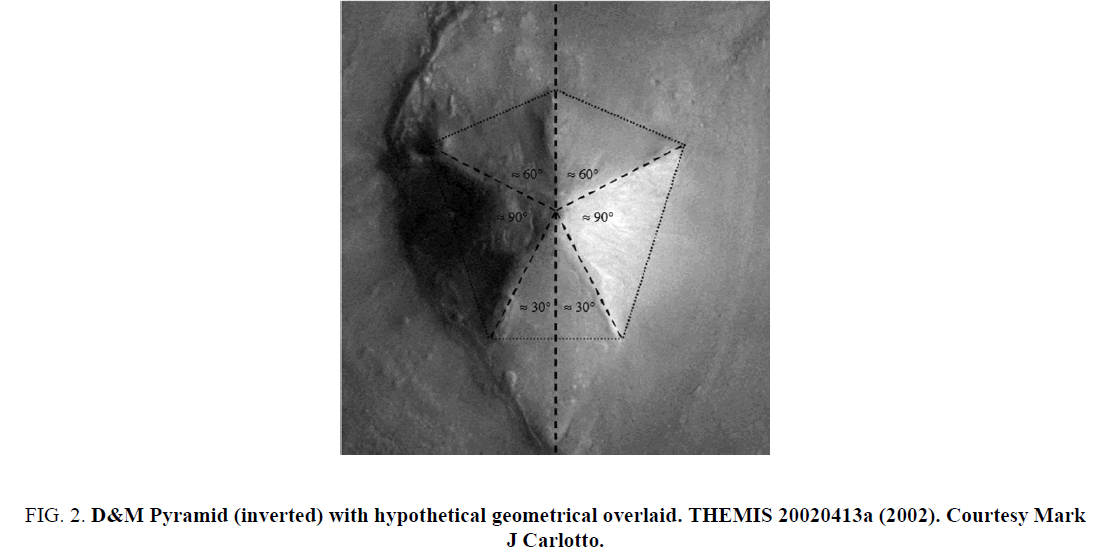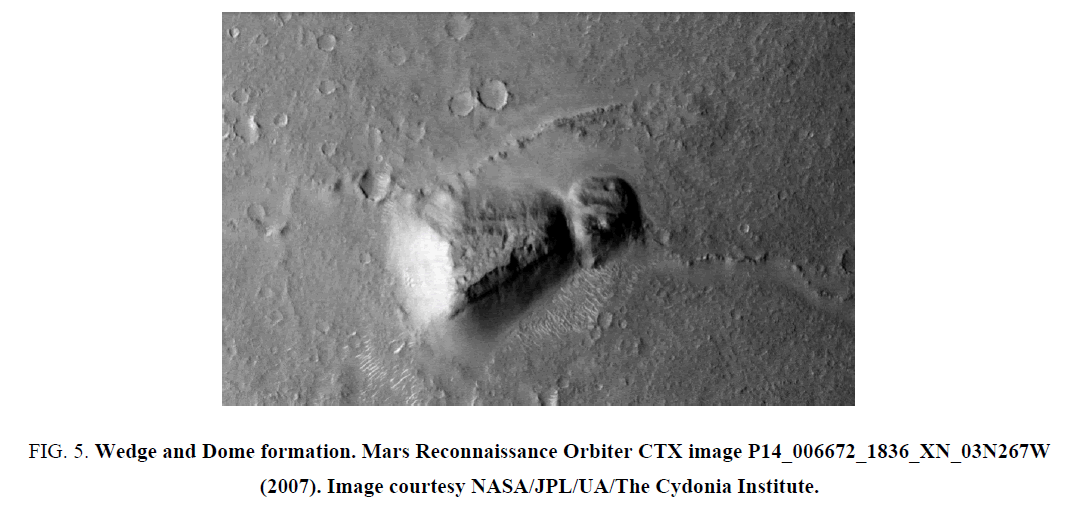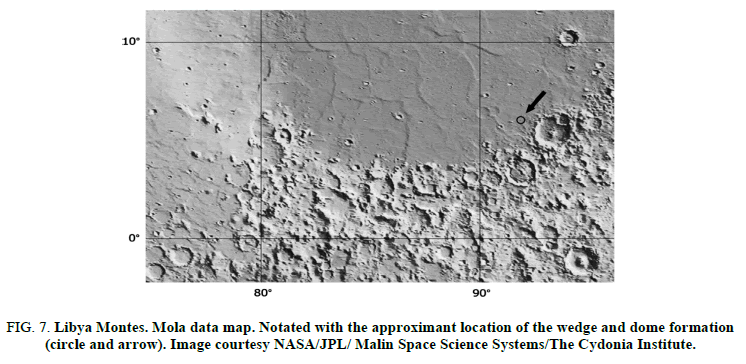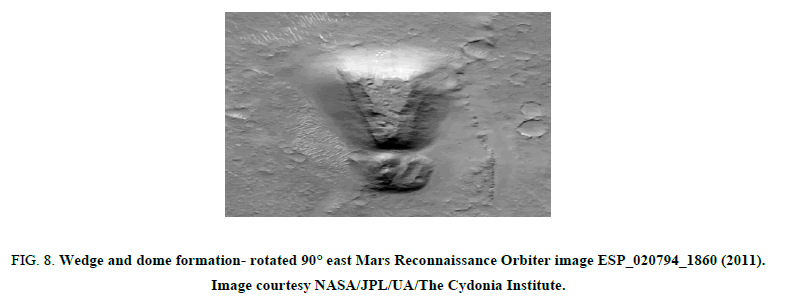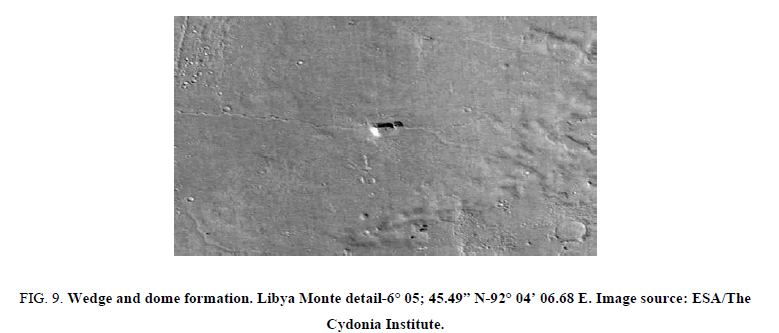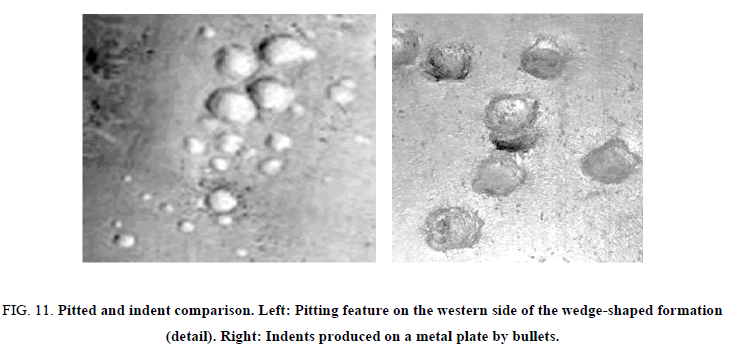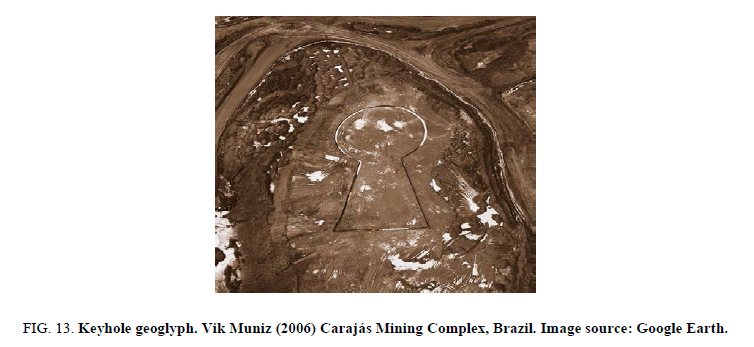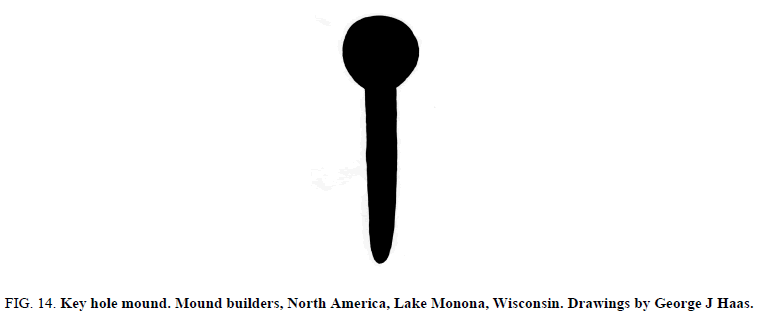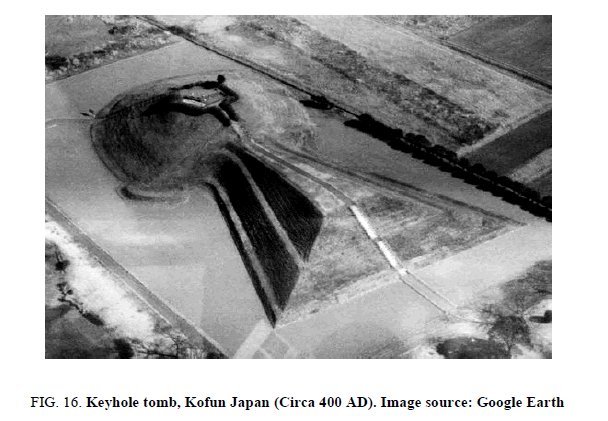Original Article
, Volume: 5( 3)A Wedge and Dome Formation Set within the Flat Plains of Libya Montes
- *Correspondence:
- Haas GJ, The Cydonia Institute, PO Box 102, Purcellville, Virginia 20132, USA, Tel: +1 215-898-5000; E-mail: thecydoniainstitute@hotmail.com
Received: September 09, 2016; Accepted: October 30, 2016; Published: November 17, 2016
Citation: Haas GJ, Saunders WR, Miller JS, et al. A Wedge and Dome Formation Set Within the Flat Plains of Libya Montes. J Space Explor. 2016;5(3):104.
Abstract
This is an examination of a wedge and dome-shaped structure observed within the flat plains of the Libya Montes region on Mars. Supportive images are provided by the Mars Odyssey and Mars Reconnaissance Orbiter spacecraft. The images reveal an anomalous structure composed of a triangular and circular component, resembling a keyhole-shape formation that exhibits a unique set of geometric measurements. The claim of intelligent design is offered and a geologist and geoscientist examine natural mechanisms that could contribute to the formation of these combined features. A terrestrial comparison of aesthetic and iconographic motifs is investigated. Further study and a request for additional images of these facial components are also encouraged.
Keywords
Libya montes; Wedge; Dome; Keyhole; Exclamation mark; Geoglyph; Mars Odyssey THEMIS; Mars Reconnaissance orbiter
Introduction
History
Between 1976 and 1980 the Viking I and Viking II orbiters obtained images and data of the Martian surface that covered the entire planet [1]. One image captured in 1976 of the Cydonia region, Viking frame 70A13, showed an anomalous mesa with a unique pentagonal-shape (Figure 1) that caught the attention of two NASA scientists, Vincent DiPietro and Greg Molenaar [2]. Titled the D&M Pyramid, after their discovery, the formation appears to expresses a remarkable set of surface angles. The team remarked that “of all the observations of pyramids on Mars, we find that this one is the most unusual [3]. On May 1, 1980, they presented the formation at a press conference held at the Ramada Inn hotel in Lanham Maryland [4] and as a result they were invited to present their work in June at the annual convention of the American Astronomical Society in College Park, Maryland [5].
Figure 1: D&M Pyramid. Viking image 70A13 (1976). Model courtesy NASA/JPL/The Cydonia Institute.
It would take over twenty-five years before a second image of the formation was taken by the Mars Odyssey THEMIS camera in 2002. The THEMIS image (20020413a) is a higher resolution image that revealed a clearer view of the formations pyramidal shape and surface angles. After reviewing the new image an electrical engineer with an expertise in digital imaging Dr. Mark Carlotto proposed that formation may indeed be artificial. He concluded that pyramidal formation is highly symmetrical and shows uniform faces measuring approximately 30°, 60°, and 90° (Figure 2). He also noted that although the left and right “arms” of the formation show a slight difference and the eastern side appears partially collapsed, the remaining surface angles can be described by isosceles and right triangular facets [6].
Figure 2: D&M Pyramid (inverted) with hypothetical geometrical overlaid. THEMIS 20020413a (2002). Courtesy Mark J Carlotto.
The original image for this study was obtained via the Mars reconnaissance orbiter (MRO) HiRISE section of the University of Arizona’s Mars Image Explorer web site. The MRO image ESP_020794_1860 was acquired on January 11, 2011. The area examined is in the Libya Montes Libya Montes region of Mars located at approximately 6.0°N and 92.0°E. The official release included a caption referring to a geometrically-shaped formation within the image as appearing as an “exclamation mark (Figure 3) [7]. On July 17, 2013, the geometrically-shape formation was brought to the attention of the first two authors of this paper and the membership of the society for planetary SETI research by Greg Orme [8].
Figure 3: Exclamation mark. Mars Reconnaissance Orbiter the MRO image ESP_020794_1860 (2011). Image courtesy NASA/JPL/UA.
The Wedge a Dome Formation
Themis image of the wedge and dome formation
In April 2001 NASA launched the Mars Odyssey spacecraft from Cape Canaveral Air Force Station in Florida. The spacecraft was equipped with an on-board camera called the thermal emission imaging system visible camera (THEMIS-VIS) that was designed to provide systematic global coverage of Mars in both the visible and IR bands [9]. The primary focus of the THEMIS investigation was to collect IR data and black-and-white images. Color images would be selective and controlled by the limitations in data rates and by NASA’s desire to focus on the IR data and obtaining global coverage in an effort to study what they call the planet's “remarkable geomorphology [10].
In November 2007, the Mars Odyssey THEMIS camera acquired narrow-angle image V26406033 with a resolution of 17.93 meters per pixel (Figure. 4) [11]. The THEMIS image shows a wedge and dome-shaped formation set within an isolated area of an expansive flat plain.
Figure 4: Wedge and Dome formation. Detail of Mars Odyssey THEMIS image V26406033 (2007) Image courtesy NASA/JPL/UA/The Cydonia Institute.
Two mars reconnaissance orbiter images of the wedge and dome formation
In 2005 the MRO spacecraft launched from Cape Canaveral in route to Mars with the High-Resolution Imaging Science Experiment (HiRISE) camera on board. The first MRO image 14_006672_1836_XN_03N267was acquired by the Orbiter’s CTX camera in December 2007 with a resolution of 5.38 pixels per meter (Figure. 5) [12].
Figure 5: Wedge and Dome formation. Mars Reconnaissance Orbiter CTX image P14_006672_1836_XN_03N267W (2007). Image courtesy NASA/JPL/UA/The Cydonia Institute.
A second MRO image ESP_020794_1860 was acquired by the Orbiter’s HiRISE camera during January 2011, with a resolution of 50 cm per pixel (Figure. 6) [13]. The two MRO images reveal defining aspects of the geometry expressed in the symmetry of a trapezoid and triangular-shaped formation adjoining a circular formation. There is a minimum of five different variations in appearance of surface materials over the small area. A geologist and geoscientist comment on natural mechanisms that could contribute to the tangent creation of the wedge and dome formations. An extensive search of comparable regions within and beyond the area of the Libya Montes was conducted and a list of these sites is provided. Terrestrial comparisons of aesthetic and iconographic motifs are also offered.
Figure 6: Wedge and Dome formation Mars Reconnaissance Orbiter HiRISE image. ESP_020794_1860 (2011). Image courtesy NASA/JPL/UA/The Cydonia Institute.
Themis and MRO ancillary data-sun and camera angles
There are considerable differences in the time frame, telemetry, sun angle, resolution and other factors of the three images; a comparison chart is presented as Table 1. The basic facial features persist throughout the four years that separate the three images and where some of the features that were obscured in the first THEMIS image are now visible in the second and third MRO images. The first photograph of the formation Mars Odyssey THEMIS image V26406033 was taken in 2007 during the winter in late-afternoon (2:06 PM) from an emission or camera angle of 0.04degrees off nadir. The THEMIS image has a resolution of 17.93 meters per pixel. The second image MRO CTX image P14_006672_1836_XN_03N267W was acquired during the winter of the same year in the late morning (8:19AM) from an emission or camera angle of 0.1 degrees off nadir at an altitude of 268.62 km (166.9 miles). The image has a resolution of 5.28 meters per pixel. The third image is a MRO HiRISE image ESP_020794_1860 that was acquired in the winter of 2011 during mid-afternoon (3:34 PM) from an emission or camera angle of 0.1 degrees off nadir. The image has a resolution of 55.0 centimeters per pixel.
| Image Number | V26406033 | P14_006672_1836_XN_03N267W | ESP_020794_1860 |
|---|---|---|---|
| Image Start time SCET | 2007-11-27 T14:06:39.809 | 2007-12-29 T08:19:08.029 |
2011-1-11 T15:34 |
| Resolution per pixel |
17.79 m | 5.38 m | 55.0 cm |
| Emission Angle | 0.04° | 0.1° | 0.1 ° |
| Incidence Angle | 67.81° | 37.09° | NA |
| Phase Angle | NA | NA | 56.5° |
| Center Longitude | 92.13° | 267.78° | 92.07° |
| Center Latitude | 5.9°N | 3.64°N | 6.04° |
| Spacecraft Altitude | NA | 268.62 km | NA |
| North Azimuth | 267.2° | 277.1° | 270.0° |
| Sun Azimuth | NA | 189.18° | 160.9° |
| Solar Longitude | 353.9° | NA | NA |
| Local True Solar Time | 2:06PM | 8:19AM | 3:34 PM |
| Release date | 11/27/2007 | 12/29/2007 | 1/11/2011 |
Table 1: Considerable differences in the time frame, telemetry, sun angle, resolution and other factors of the three images; a comparison chart is presented as.
The geological context for the wedge and dome formation
Libya Montes is located in the Syrtis Major hemisphere of Mars between latitudes 0.1°N and 4.0°N, longitudes 271.5°W and 279.9°W (Figure. 7). It is part of the eroded and cratered remains of the southern rim of an ancient impact basin called Isidis Planitia. Much of the region consists of networks of valleys that run northward toward this large drainage basin. It has the appearance that water altered the geology at one time and may have heavily eroded this highland region and deposited sediment in its lowlands. This intriguing area has generated much debate amongst researchers in the scientific community as to how these highly modified and eroded valley networks actually formed. The wedge and dome formation is located on the edge of Libya Montes, near 6.4° N and 92.0° E (268.0° W).
Figure 7: Libya Montes. Mola data map. Notated with the approximant location of the wedge and dome formation (circle and arrow). Image courtesy NASA/JPL/ Malin Space Science Systems/The Cydonia Institute.
A geological explanation of the wedge and dome formation (Figure. 8) is offered on the University of Arizona’s web site by Dr. Alfred S. McEwen, a Professor of Planetary Geology, at Arizona State University [14]. McEwen states “the origin of these hills may be difficult to understand on such ancient terrain. The straight edges suggest fractures related to faults. Maybe this feature was lifted by the faulting, maybe the surrounding terrain has been eroded down over billions of years, or both [15].
Figure 8: Wedge and dome formation- rotated 90° east Mars Reconnaissance Orbiter image ESP_020794_1860 (2011). Image courtesy NASA/JPL/UA/The Cydonia Institute.
There is really no visual evidence that this wedge and dome were thrust upwards by faulting. In fact, if the extended line running across the terrain (Figure. 9) is a fault line, it runs between the wedge and the dome. If one side is thrust up the other side must be down. This is not the case nor is there evidence of thrusting anywhere else along this line. If the features are glacial erratics there remains the question of why the wedge still has such prominent ridge lines while the tangent mound has been rounded off. An expansive search of the surrounding terrain was conducted within the available dataset and no self-similar formations were observed within or outside the region. It does not seem logical to have two structures totally isolated on an open plain side by side and exposed to the same erosional forces to exhibit such dramatic, geometrically opposing shapes.
Figure 9: Wedge and dome formation. Libya Monte detail-6° 05; 45.49? N-92° 04? 06.68 E. Image source: ESA/The Cydonia Institute.
Dunes are formed around the perimeter of the wedge and dome formation in four different directions (Figure. 10). The dunes observed on the western end of the wedge indicate wind from opposite directions. One would expect to see interference dune pattering where these opposing winds meet, but that is not the case here. It is also peculiar that there are no dunesor reworking on the apparently loose detritus material on the south side of the structure. There is also evidence of clustered pitting on the western edge of the wedge formation and within the dome formation (Figure. 5). This clustered pitting is also difficult to explain. The pitting observed in the surface appears as indentations within a hard-metallic surface or the remains of surface material being gauged out rather than the result of an impact on surface material.
Figure 10: Dunning and pitting on the wedge and dome formation. Notation by William Saunders. Image source: Mars Reconnaissance Orbiter image ESP_020794_1860, (2011). Image courtesy NASA/JPL/UA/The Cydonia Institute.
The pitting observed on the surface of the western side of the wedge formation appears as indentations within a hard-metallic surface or the remains of surface material that has been gauged out or indented by the impact of explosive projectiles. When these pitted features are compared to the indents left by bullet impacts on a metal plate a common imprint is offered for comparison (Figure. 11).
Figure 11: Pitted and indent comparison. Left: Pitting feature on the western side of the wedge-shaped formation (detail). Right: Indents produced on a metal plate by bullets.
Geometrical analysis of the wedge and dome formation
Assuming there was extensive erosion over the surface of these structures, this pair of tangent formations exhibit remarkable symmetry. This symmetry goes against natural mechanisms. Symmetry, in nature, is found in biological systems whereas inanimate objects exposed to environmental forces trend towards randomness and abstraction. The formation is approximately 2,669 meters in length from the western side of the wedge form to the eastern edge of the dome form. It is approximately 1109 meters wide at its most western edge, from letter a to letter c in Figure. 12a, while the dome formation is approximately 775 meters in diameter.
Figure 12: Wedge and dome formation. Analytical drawings a (left) and b (right) by George J. Haas. Image source: Mars Reconnaissance Orbiter image ESP_020794_1860, 2011.
The geometry of the wedge and dome formation represents two very basic geometries; the 360° circle and the 180° isosceles triangle (Figure. 12b). The large dome-shaped formation, located directly below the wedge-shaped formation appears almost circular, while the overall shape of the wedge formation takes on the form of a trapezoid with an isosceles triangle on its uppermost surface. The angles of this triangle are x and y=75° and z=30°, adding up to 180° (Figure. 12b).
The line i drawn to bisect ridgeline a to point c also bisects lines from points e and f, along with points g and h and points b and d demonstrating the bilateral symmetry to the wedge or trapezoid section. The upper and lower ridges of the wedge appear as nearly perfectly straight lines running parallel to each other (Figure. 12a). The lower ridge line extending from point a to point b is parallel to the upper ridge line that extends from point e to point g. The adjoining upper ridge line, extending from point f to point h is parallel with the lower ridge line extending from c to point d.
Cultural Reference
Keyhole design
There is a long history of world-wide cultures utilizing the key-hole shape to produce a variety of graphic based designs and monumental structures. This rich legacy extends well into contemporary projects such as this elegant keyhole formation created in South America by Brazilian Land Artists Vik Muniz (Figure. 13). Inspired by the design of classic icons used in popular culture Muniz produced the outline of a traditional keyhole formation in 2006 on a large plot of land owned by the Carajás Mining Complex, in Northern Brazil [16].
Figure 13: Keyhole geoglyph. Vik Muniz (2006) Carajás Mining Complex, Brazil. Image source: Google Earth.
An earlier example of a terrestrial wedge and dome-shaped “keyhole” formation was produced by the early inhabitants of North America the area, known as the Mound Builders. The formations situated on a ridge along the eastern side of Lake Monona, near the City of Madison, Wisconsin (Figure. 14). Referred to by archaeologists as a “war club” the circular, dome-shaped section of the formation is 36 feet across, while the extending wedge form is 165 feet long measuring 20 feet wide at its widest part [17].
Figure 14: Key hole mound. Mound builders, North America, Lake Monona, Wisconsin. Drawings by George J Haas.
Moving across the globe to Western Asia, towards the Al-Hayit and Khaybar regions of Saudi Arabia, there are dozens of keyhole shaped tombs that were discovered in 2009 with the aid of Google Earth (Figure 15)[18]. Thought to be over 6,000 years old [19] the main body of these tombs takes the shape of an isosceles triangular with a circular mound attached at its vertex that are commonly aligned with the rising sun [20].
A massive keyhole-shaped tomb built in Kofun Japan (Figure. 16) has the classic wedge and dome-shaped design that is highly comparable to the wedge and dome-shaped formation observed on Mars. The well preserved tomb is an earthen mound that is thought to have been built in the 5th century, measures 120 meters long [21]. While examining many of these ancient key-shaped tombs found in Japan Dr. Robert Schoch, a professor of Natural Science at the College of General Studies, at Boston University, stated that he believes that many of these ancient keyhole-shaped tombs may have been created as geoglyphic markers, signaling the attention of aerial travelers to, “stop and look here” [22].
When the keyhole-shaped tomb produced in Japan is compared to the wedge and dome formation observed on Mars, their common design qualities becomes quite apparent (Figure. 17).
Figure 17: Wedge and dome comparison. Left: Mars formation. Image source: Detail of MRO image ESP_020794_1860, (2011). Right: Kofun Japan (400 AD). Image source: Google Earth.
Conclusion and Recommendations
The two opposing components that produce the wedge and dome formation within the Libya Montes region of Mars is persistent in three images taken by two different NASA spacecraft at three different times over a four-year period. The formation is accurately depicted in Mars Odyssey THEMIS image V26406033 and again in two Mars Reconnaissance Orbiter images, MRO CTX image P14_006672_1836_XN_03N267W and MRO HiRISE image ESP_020794_1860. The structural design of this unique formation remains exceptional in regards to its geometry and symmetry. The continuity of architectural references is eloquently expressed within the monuments produced by New World, Middle Eastern and Japanese cultures where a common aesthetic is strongly supported.
The wedge and dome features observed in this formation are well proportioned and highly symmetrical despite the actions of natural depositional and erosional agents. While there are known geological mechanisms that are capable of creating and destroying the individual angles and planes presented in this formation, the natural creation of two opposing geometrically designed formations seems to go well beyond the probability of chance. Considering the historic study of potentially artificial structures on Mars, beginning with the face on Mars and the D&M Pyramid found at Cydonia, the wedge and dome formation of Libya Montes provides compelling support for a broader investigation by independent planetary scientists.
Therefore, we conclude that the structural mechanisms that produce the wedge and dome formation at Libya Montes are highly unusual and exhibit a level of geometry and symmetry that is unequaled within Martian aerography. We recommend that both NASA and the imaging team at the University of Arizona direct the current MRO spacecraft acquire addition images of this anomalous surface feature. New images should be acquired at different times of day and under various sun angles for further analysis. If this formation is found to be consistent, we would encourage the pursuit of “ground truth” and recommend this site as a prime candidate for the study of potential archaeological artifacts on Mars.
Acknowledgments
The authors are grateful to Greg Orme for bringing this formation to our attention in 2013 and for his kind assistance and review of early drafts of this paper. We also acknowledge Dr. Mark Carlotto, Dr. John Brandenburg and Ananda Sirisena for their comments and suggestions in regards to reviewing earlier drafts of this paper. Very special thanks goes to NASA and the University of Arizona for the use of the Mars Odyssey THEMIS and Mars Reconnaissance Orbiter images that are available on their public web sites. Lastly we are indebted to Zenith Haas for the editing and formatting of this paper.
References
- Viking 1 & 2. NASA Mars Exploration. Program & Missions. 1975.
- DiPietro V, Molenaar G. Unusual Martian Surface Features. Mars Research. 1982.
- Carlotto M. The Cydonia Controversy. Lulu.com; 2008. 47p.
- Boeche R. Journal of the Fortean Research Center Paperbound. Lulu.com; 2012. 10p.
- Carlotto M. The Cydonia Controversy. Lulu.com; 2008. 47p.
- Mark JC. Analysis of Mars Odyssey THEMIS Imagery of the "D&M Pyramid. New Frontiers in Science. 2002;1(3).
- Mars Reconnaissance Orbiter HiRISE, [Internet]. Exclamation Mark on Mars, ESP_020794_1860, dated January 2, 2011. http://www.uahirise.org/ESP_020794_1860.
- George Haas. Personal e-mail communication from Greg Orme, July 17, 2013.
- Mars Odyssey THEMIS. About Mars Odyssey &themis [internet]. Mars Space Flight Facility, Arizona State University [cited on 2016 November 16]. Available from: http://themis.asu.edu/about
- James Miller. Personal e-mail communication with the Principal Investigator for the 2001 Mars Odyssey Thermal Emission Imaging System (THEMIS) instrument, Philip Christensen, July 18, 2002.
- Mars Odyssey (2007) THEMIS image V26406033, dated November 27
- Mars Reconnaissance Orbiter HiRISE, Libya Montes, CTX P14_006672_1836_XN_03N267W, December 29, 2007. http://hirisepds.lpl.arizona.edu/PDS/EXTRAS/RDR/ESP/ORB_020700_020799/ESP_020794_1860/ESP_020794_1860_RED.browse.jpg
- Mars Reconnaissance Orbiter HiRISE, Exclamation Mark on Mars, ESP_020794_1860, January 2, 2011. http://www.uahirise.org/ESP_020794_1860.
- Dr. Alfred S. McEwen, The Department of Planetary Sciences/Lunar and Planetary Laboratory. http://www.lpl.arizona.edu/people/faculty/mcewen.html
- Dr. Alfred S. McEwen, Exclamation Mark on Mars, NASA/JPL/University of Arizona, January, 12, 2011.
- Nichido Contemporary Art, Viki Muniz, Pictures of Earthwork, (Chuo-ku, Tokyo, Japan), 2009.
- Stephen D. Peet, State Historical Society of Wisconsin, Collections-State Historical Society of Wisconsin, (The University of California, General Books LLC, 1882), 49.
- David L. Kennedy, Desktop Archeology, Aramco World, July/August, Volume 60, Number 4, 2009.
- Kessler R. Thousands of Tombs in Saudi Desert Spotted from Space. Live Science. February 15, 2011.
- Carolina Sparavigna A. A Prehistoric Solar Observatory in the Middle of Sahara Desert. 2014:428.
- Heritage of Japan. Discovering the Historical Context and Culture of the People of Japan. Towering tumuli of the Kofun era. 2013, 4p.
- Schoch R. Secrets of the Tombs. Ancient Aliens. Season 5 Episode aired January 25, 2013.

